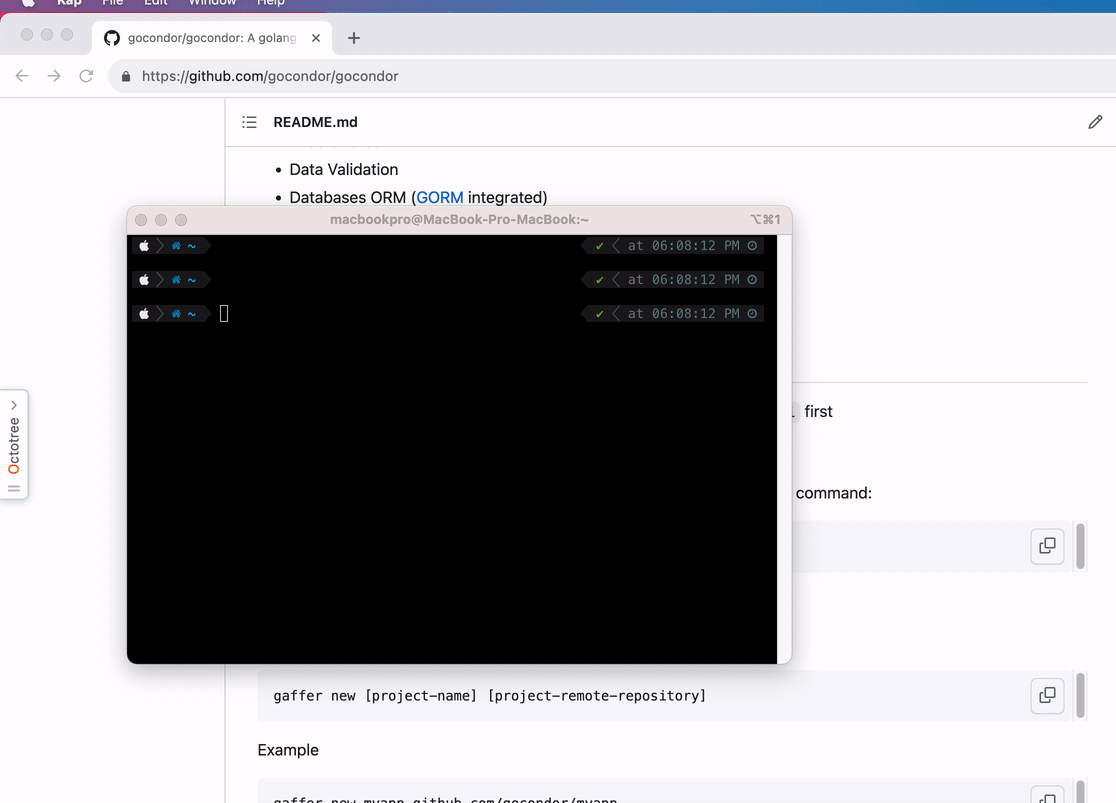4.7 KiB
Cup of Goffee
What is GoCondor?
GoCondor is a Go web framework made for building web APIs, suitable for small, medium size and microservices projects. With it's simple structure, and developer friendly experience it helps with increasing the productivity.
Main Features
- Routing
- Middlewares
- Data Validation
- Databases ORM (GORM integrated)
- Emails
- JWT tokens
- Cache (Redis)
- HTTPS (TLS)
Installation
To create a new GoCondor project you need to install the GoCondor's cli first
Install Gaffer [GoCondor's cli] tool
To install the gaffer globally open up your terminal and run the following command:
go install github.com/gocondor/gaffer@latest
Create new project using a Cup of Goffee
Here is how you can create new goCondor projects using gaffer
gaffer new [project-name] [project-remote-repository]
Example
gaffer new myapp github.com/gocondor/myapp
where:
project-name is the name of your project
remote-repository is the remote repository that will host the project, usually github.com is used.
Getting started
First make sure you have Gaffer installed, then use it to create a new project, here is how
Let's create a route that returns hello world
Open up the file routes.go in the root directory of your project and add the following code:
router.Get("/greeting", func(c *core.Context) *core.Response {
JsonString := `{"message": "hello world"}`
return c.Response.Json(JsonString)
})
Next, in your terminal navigate to the project dir and run the following command to start the live reloading:
gocondor run:dev
Finally, open up your browser and navigate to http://localhost/greeting
To learn more check the routing docs section
Architecture
The architecture is similar to MVC, where there is a routes file ./routes.go in which you can map all your app routes to their controllers which resides in the directory ./controllers. Controllers are simply methods that handles requests (GET, POST, ... etch) to the given routes.
The request journey:
The first component that receive's the request in Cup is the Router,
then Goffee locates the matching handler of the request and it check's if there are any middlewares to be executed either before or after the handler, if so, it executes them in the right order, then at the final stage it returns the response to the user.
Request -> Router -> Optional Middlewares -> Handler -> Optional Middlewares -> Response
Folder structure
├── cup
│ ├── config/ --------------------------> main configs
│ ├── events/ --------------------------> contains events
│ │ ├── jobs/ ------------------------> contains the event jobs
│ ├── controllers/ ------------------------> route's controllers
│ ├── logs/ ----------------------------> app log files
│ ├── hooks/ ---------------------> app hooks
│ ├── models/ --------------------------> database models
│ ├── storage/ -------------------------> a place to store files
│ ├── tls/ -----------------------------> tls certificates
│ ├── .env -----------------------------> environment variables
│ ├── .gitignore -----------------------> .gitignore
│ ├── go.mod ---------------------------> Go modules
│ ├── LICENSE --------------------------> license
│ ├── main.go --------------------------> go main file
│ ├── README.md ------------------------> readme file
│ ├── register-events.go ---------------> register events and jobs
│ ├── register-global-hooks.go ---> register global middlewares
│ ├── routes.go ------------------------> app routes
│ ├── run-auto-migrations.go -----------> database migrations

